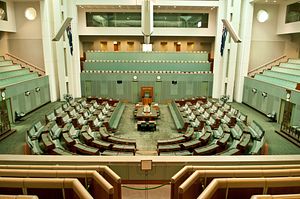Over the past few weeks, the Australian parliament has seen a decidedly high number of inconclusive and frustrating political setbacks – not only for the government, but for all political parties. The mining tax repeal, superannuation changes, and a raft of social spending cuts currently making their way through the Senate have all been discussed and debated at great length. But an obstinate opposition and reluctant compromises that have so often followed are not only allowing politicians to shift the blame for unpopular decisions (or the lack thereof) but also making it harder for voters to figure out whether the end results are actually in Australia’s national interest.
On September 2, Prime Minister Tony Abbott at last succeeded in fulfilling one of his key election pledges when the Senate voted to repeal the Mineral Resources Rent Tax (MRRT), which taxes profits from Australia’s non-renewable resources and was first introduced under Labor. The bill will now head back to the House of Representatives this week where it’s certain to pass. The government bill, which reduces some of the spending measures that had been linked to the tax, will lead to savings of around $10 billion over the next four years. But the political wrangling required to secure the deal will still set back the government’s goal of balancing the budget.
To secure the support of the crossbenchers in the Palmer United Party (PUP), the government agreed to maintain a raft of social spending items such as the schoolkids bonus, an income support bonus, and super contributions for low-income earners until at least 2016-7. This has proven to be a hugely expensive compromise. The deal will end up costing an estimated $6.5 billion, so instead of what was supposed to be $16.5 billion of spending cuts the government is left with decidedly less impressive savings of $10 billion.
This has led to a rather dysfunctional state of affairs in which the populist mining magnate Clive Palmer selectively champions the interests of poor, working class families all the while extracting a disproportionate number of concessions from a government, overeager to fulfill at least some of its election promises. The most telling example was the government’s decision to delay an increase in the compulsory superannuation rate to 12 percent from 2022 to 2025 (the current rate is 9.5 percent). Abbott claims this will “keep more money in workers’ pockets” but given the implications for government pension payments, the policy sits at odds with a government touting the importance of fiscal austerity and the need to balance the budget.
The difficulty for the opposition is that the initial proposal to increase the compulsory superannuation rate to 12 percent by 2019 was made under Labor and was set to be funded by the MRRT, which never delivered on the overly optimistic expected revenue. Failing to clarify and account for such policy missteps only weakens the opposition’s argument. It was perhaps telling that the most effective critique came from former Labor Prime Minister Paul Keating (and creator of Australia’s superannuation system), who questioned the rationale of providing foregone super contributions in the form of higher wages. “If Tony Abbott’s argument about the value of cash today had substance, there would be no savings,” he said, challenging the government’s commitment to ending what it calls the “age of entitlement.”
The problem, though, is that neither Labor nor the Coalition are dealing with the much larger issue of pension eligibility. As Adam Creighton, The Australian’s Economics Correspondent, noted, “The age pension eligibility test is a joke, granting a part-pension to retirees with ‘family homes’ of any value and financial assets up to $1.134 million.” He cites a National Commission of Audit report, which projects that although the proportion of people receiving a full pension will decline, this will be almost entirely cancelled out by an increase in people receiving a part-rate pension. The proportion of older Australians eligible for the Age Pension, the report concludes, will therefore remain constant at around 80 percent over the next forty years or so.
Dealing with these types of serious, long-term policy challenges in a measured and considered manner ought to be within the purview of parliament. But not this parliament, it would appear.

































